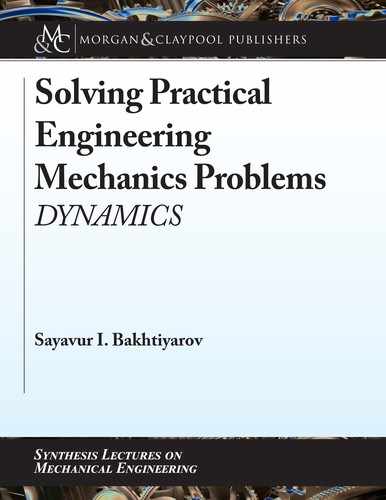
28 2. TOPIC D-2
a)
b)
M(x/z)
φ
z
x
O
M(x/z)
φ
z
x
O
P
G
r
Figure 2.31.
2.3 SOLUTION
e particle M is under the action of the gravity force G
and the force P
with the line of action crossing the
non-moving center O (Figure 2.31b). e force P
attracts the particle M to the center O. A magnitude of this force
is proportional to the distance r from the point M to the center O.
Initially (t =0), the particle M is located at the axis x and 10 m from the center O. e initial velocity of the
particle M is 40 m/s and it is directed vertically upward.
e given forces P
, G
and the initial velocity vector are located at the plane xOz and, therefore, a further mo-
tion of the particle will take place on this plane.

29
e dierential equations of motion of the particle M:
m = ∑ F
xi
,
mz
̈
= ∑ F
zi
.
e sums of the x and z components of the forces given in this problem:
F
xi
= P
x
= –4r cos φ ,
F
zi
= P
z
– G = –4r sin φ – G .
As cos φ =
x
, sin φ =
z
, then
r
r
F
xi
= –4x, F
zi
= –4z – G.
Hence:
= –4x,
z
̈
= –4z – g or
+ 4x = 0, (2.1)
z
̈
+ 4z = –g. (2.2)
Equations (2.1) and (2.2) are second-order linear dierential equations with constant coecients. Equation (2.1) is
a homogeneous, and Equation (2.2) is an inhomogeneous types dierential equations.
A characteristic equation of Equation (2.1):
u
2
+ 4 = 0. (2.3)
e roots (solutions) of this equation:
u
1,2
= ±2i, (i = √–1). (2.4)
A general solution of Equation (2.1):
x = C
1
cos 2t + C
2
sin 2t. (2.5)
A dierential of Equation (2.5):
= 2(–C
1
sin 2t + C
2
cos 2t). (2.6)
e integral constants C
1
and C
2
are determined using the initial conditions:
10 = C
1
cos 0 + C
2
sin 0 ,
0 = 2(–C
1
∙ sin 0 + C
2
∙ cos 0).
en:
C
1
= 10 and C
2
= 0. (2.7)
2.3 SOLUTION

30 2. TOPIC D-2
Hence, the equation of motion is:
x = 10 cos 2t . (2.8)
A general integral of the inhomogeneous equation (2.2):
z = z
*
+ z
**
, (2.9)
where z
*
is a general solution of the respective homogeneous dierential equation:
z
̈
+ 4z = 0. (2.10)
z
**
is a particular solution of the inhomogeneous dierential Equation (2.2).
Equations (2.1) and (2.10) are similar. erefore, a general integral of Equation (2.10):
z
*
= C
3
cos 2t + C
4
sin 2t. (2.11)
A particular solution z
**
will be:
z
**
= A = const. (2.12)
A substitution of (2.12) in Equation (2.2) will yield:
0 + 4A = –g, A = –
g
= –2.45. (2.13)
4
Hence:
z = C
3
cos 2t + C
4
sin 2t – 2.45. (2.14)
A rst derivative of Equation (2.14):
= 2(–C
3
sin 2t + C
4
cos 2t ). (2.15)
Applying initial conditions at t = 0, Equations (2.14) and (2.15) can be rewritten as:
0 = C
3
∙ 1 + C
4
∙ 0 – 2.45,
40 = 2(–C
3
∙ 0 + C
4
∙ 1).
en: C
3
= 2.45 and C
4
= 20.
Finally:
z = 2.45 cos 2t + 20 sin 2t - 2.45 (m). (2.16)
Equations (2.8) and (2.16) are the solutions of the problem.
..................Content has been hidden....................
You can't read the all page of ebook, please click here login for view all page.
